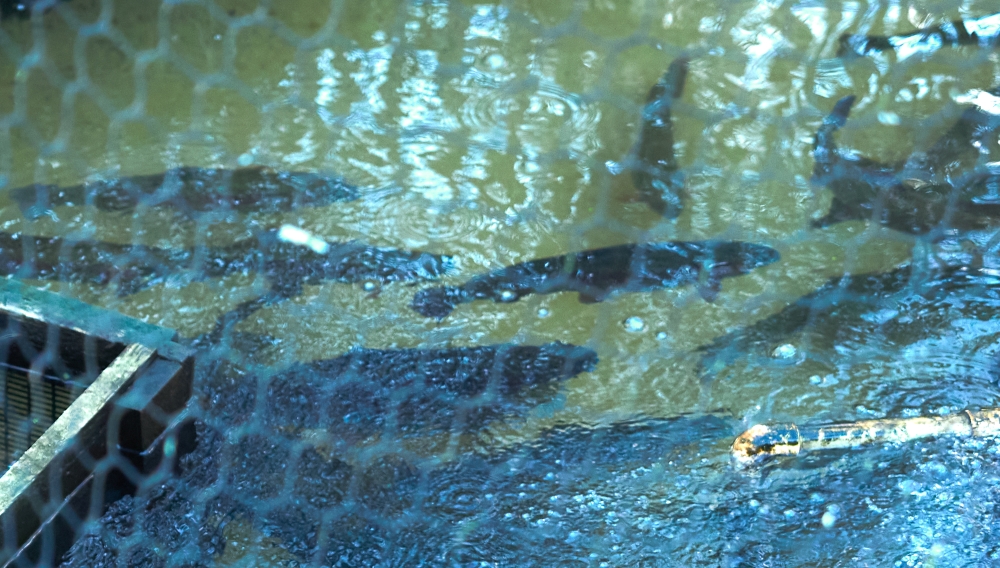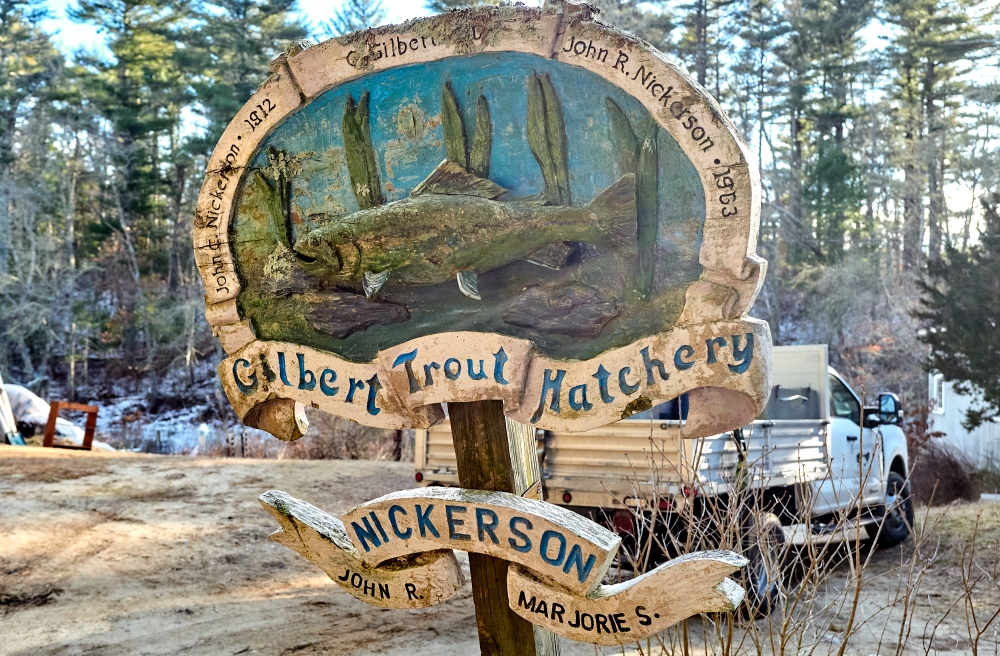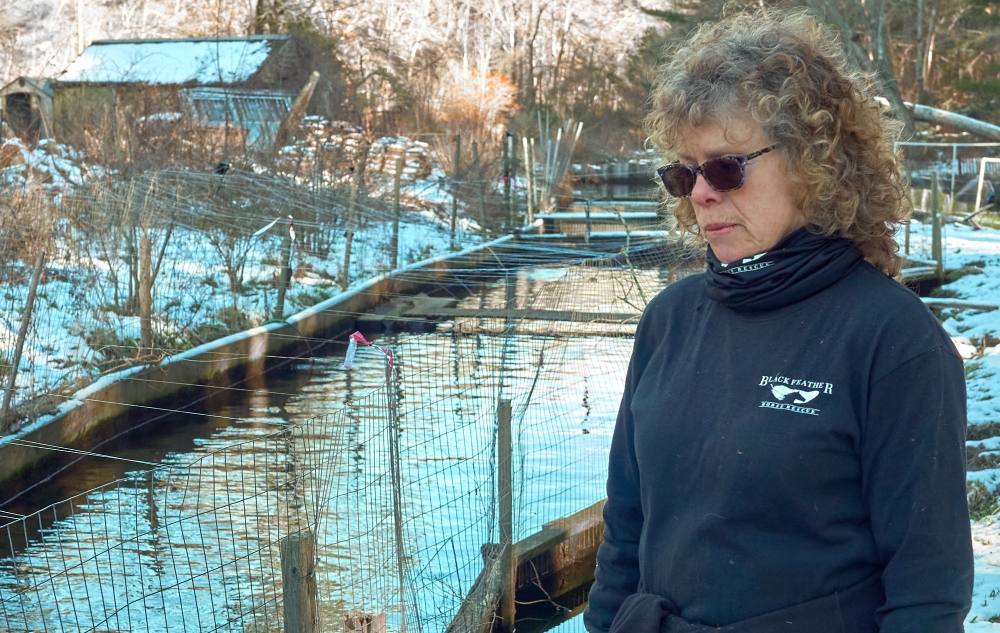Last fall, fish started dying at Darlene Nickerson’s trout hatchery in Chiltonville.
“I knew I should have been testing my water, but it’s expensive,” said Nickerson – who owns Gilbert Trout Hatchery – during a recent walk along her fence-lined and netting-covered brook. “But when you lose them it’s just heartbreaking.”
After she finally decided to have the water tested, the lab results showed e. coli in the headwater of the brook and the downstream end, also called the bottom. Nickerson does not know what caused the contamination, but she wonders about the nearby Plymouth wastewater treatment plant at Camelot Park. She fought against the plant in the ‘90s, when it was built, and now she worries about the town’s plan to divert treated wastewater from Plymouth Harbor to the industrial park.
Plymouth Harbor has long been the primary destination of the town’s treated sewage water. The state allows it to pump up to 1.75 million gallons a day into the harbor and an additional 750,000 gallons daily into the treatment beds at the Camelot Park plant.
Now, the town is seeking permission to make the five rapid sand infiltration beds at Camelot Park the primary destination for treated wastewater, keeping the harbor pipe as backup or for use in emergencies. It’s seeking state permission to increase the maximum volume handled by the sewage treatment plant from 2.5 million gallons a day to 3 million, with the goal of moving more homes and businesses off septic systems and to allow the town to treat excess runoff after storms, Neal Price, a consultant hired by the town, explained to the Select Board in December.
The goal is to improve water quality in Plymouth Bay, Price said. He explained that transferring the treated water from the harbor to Camelot Park would reduce the amount of nitrogen discharged into the ocean, and thus reduce the amount algae blooms in the harbor, as saltwater algae feed on nitrogen.
It would also eliminate viruses that threaten the oyster beds in Plymouth, Kingston, Duxbury, and Scituate, said Kendra Martin, water and wastewater engineer for the town.

In 2022, as the result of a 2018 dye test that showed how far out wastewater from the outflow pipe traveled before it was diluted to desirable levels, the Massachusetts Department of Fisheries reclassified Plymouth Harbor, Plymouth Bay, Kingston Bay, and Duxbury Bay as only partially safe for shellfish consumption. It prohibited harvesting of shellfish from an expanded portion of Plymouth Harbor. It also applied a “conditional” designation to harvesting from Kingston Bay, southern Duxbury Bay, northern portions of Plymouth Harbor, and westerly portions of Plymouth Bay. That means that shellfish caught in those areas can be sold in the United States but – under European Union rules – may not be exported to the EU.
Former Select Board member David Malaguti worries that if the viruses are diverted to Camelot Park, they will still eventually find their way to the Eel River and back to the harbor, this time where the river meets the harbor, rather than in the deeper water where the outflow pipe is located. He fears that if the town stops using the harbor pipe as its primary outflow for treated water, it could lose the right to use it altogether.
“We have a federally grandfathered discharge (into the harbor),” Malaguti said. “Other cities and towns would kill for that.”
Another goal of pumping the water at Camelot Park is to recharge depleted groundwater. When water is poured into the five infiltration beds at the park, the water table there will rise by 12 feet, Price said.
Most of the water discharged at Camelot Park will work its way into the Eel River, he said. But the closest stream to the discharge beds is Warren Wells Brook, Price said.
“This is the area of greatest concern,” he said, especially with phosphorous migration.”
Price explained that phosphorous is of concern because it causes algae growth in fresh water. Price said phosphorous is held back in groundwater and tends to move slowly, at a rate of about 12 feet per year. So if the plant were to discharge treated water for 50 years into the beds and then shut off, at the end of 80 years, the phosphorous would just barely get to Warren Wells Brook, Price said.
Warren Wells Brook is where Nickerson raises her trout.
The town is planning to file a draft environmental impact report with the Massachusetts Environmental Protection Act Office this summer. It is proposing to put in monitoring wells between the discharge beds and Warren Wells Brook to measure phosphorus, Price said.
“What we’re talking about is a clear and obvious benefit to the harbor with potential impacts to the Eel River that might be noticeable or might not, to be determined, to be analyzed further in this process, and also to be observed through this monitoring process,” he said.
To mitigate the discharge of phosphorus, the town could increase the plant’s capacity to treat phosphorus, Price said.

Malaguti, who served 22 years on the Select Board and remembers when the plant was built, doesn’t like the idea of the treated water reaching the Eel River.
“I think it’s a horrible mistake,” he said. “Nobody knows the impact on the Eel River.”
Malaguti pointed out that Nickerson’s hatchery is directly downstream from where the treated water would be discharged.
“It’s going to destroy her trout hatchery,” he said.
Malaguti also has concerns about the impact of additional water on the aging Russell Mill Pond Dam, which is on the Eel River.
In his presentation before the Select Board, Price downplayed the impact, saying said that the amount of water the treatment plant would add to the ground is relatively small compared with what big storms produce.
“If these structures have — and they have — held up over large rainstorm events, then this amount of additional water that’s being added is relatively minor in comparison to that,” he said.
Town Manager Derek Brindisi said he will recommend to the Select Board that it appoint an advisory committee to monitor the project. The committee would inform town officials and abutters about its progress.
For now, Nickerson isn’t convinced by the assurances.
“It’ll bury me,” she said. She’s afraid that the water temperature could increase and harm her trout, which are cold-water fish.
The hatchery has been around since 1869. Nickerson’s grandfather bought it, and her father put 80 acres into conservation restriction with New England Forestry. He raised brook trout and she remembers riding with him in his International Harvester truck to deliver the fish to customers.
“When I go down those roads, I’m right back to when I was a little girl in the big truck bouncing on the seat,” she said.
To keep up with the competition, Nickerson also raises rainbow trout, which resist temperature change better and grow twice as fast as brook trout. She sells mostly to fishing clubs throughout Massachusetts.
Her hatching pools have screens at the head and bottom. Netting protects the fish from wildlife, such as otters, blue herons, mink, muskrat, raccoons, kingfishers, and the occasional osprey. They all love to feed on trout.
The brook flows into the Eel River. Upstream from the hatchery, you can see the blades of a windmill at Camelot Park peeking over a hill. It’s a 10-minute walk away, Nickerson said. The headwaters of the brook come from springs and from wetlands that back up to Camelot Park. It’s beautiful and fragile. Nickerson believes its future may be in peril.
“I’m scared,” she said.
Fred Thys can be reached at fred@plymouthindependent.org.

